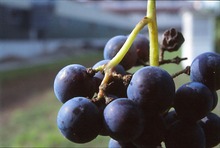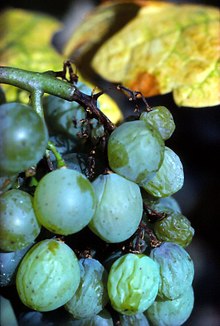Stalk paralyzes
Stalk paralysis is a disruption of the cell structure of the grape stems / grape combs in grapevines and is a physiological disorder and is assigned to wilt diseases . The dead stalk structure is then often attacked by the botrytis fungus and manifests itself in the unwanted stem rot . The result is that the stem structure no longer provides any mechanical support and parts or whole grapes fall to the ground (soil clusters). The first symptoms can appear around the blooming time of the vines , but usually only suddenly after the start of ripening (stage 81 according to the BBCH scale for grapevines ) and particularly affect the main axis of the grape frame. The grapes affected in this way usually - depending on the stage at the first infestation - cease further ripening development, which, in addition to the loss of quantity, also leads to severe yield losses, whereby in the case of white wine varieties in later stages of an infestation there can also be a concentration of ingredients.
The extent of damage varies from year to year, whereby the location, the grape variety and the rootstock used are decisive. The varieties Riesling , Blaufränkisch , Blauburger , Welschriesling , Muskateller , Müller-Thurgau , Traminer , Gutedel , Trollinger , Roeslier and Cabernet Sauvignon are particularly susceptible to stalk paralysis . But the Faber , Perle von Alzey , Rieslaner , Segalin and Sirius grape varieties are also more susceptible than average.
Cause complex
Have a supporting and triggering effect:
- Magnesium deficiency or an unfavorable potassium / magnesium ratio of over 5: 1 in the grape structure: A magnesium deficiency weakens photosynthesis in the plant, reduces protein synthesis and slows down the energy metabolism. Potassium can hinder the absorption and further transport of magnesium in the plant.
- too dense foliage and the associated lack of exposure of the grapes
- strong vegetative growth: excessive shoot growth hinders good fruit set and the formation of a strong grape structure.
- strong weather changes during the flowering period favor the occurrence
- frequent alternation between dry seasons and high amounts of precipitation
- shallow soils
The rootstock SO4 , which is sensitive to drought and which also has a low Mg absorption capacity, promotes stem paralysis and grape wilt.
Web links
- Stalk paralysis - symptoms, causes and control . Vine protection service Lower Austria
- Stalk paralyzes
- Werner Siegfried, Hans Jüstrich: Occurrence and control of the stalk paralyzes . In: Schweizer Zeitschrift Obst-Weinbau, No. 15/06
- Monika Riedel: Targeting grape wilt and stalk paralysis (PDF; 223 kB)
- Stalk Paralyzes: Recommendations for Practice
literature
- Karl Bauer, Ferdinand Regner , Barbara Schildberger: Viticulture . 9th edition. avBook published by Cadmos Verlag, Vienna 2013, ISBN 978-3-7040-2284-4 .
- Horst Diedrich Mohr (Hrsg.): Color atlas diseases, pests and beneficial insects on the grapevine . 2nd Edition. Eugen Ulmer, Stuttgart 2011, ISBN 978-3-8001-7592-5 .
Individual evidence
- ^ Karl Bauer, Ferdinand Regner , Barbara Schildberger: Weinbau , avBuch im Cadmos Verlag, Vienna, 9th edition 2013, ISBN 978-3-7040-2284-4 .

